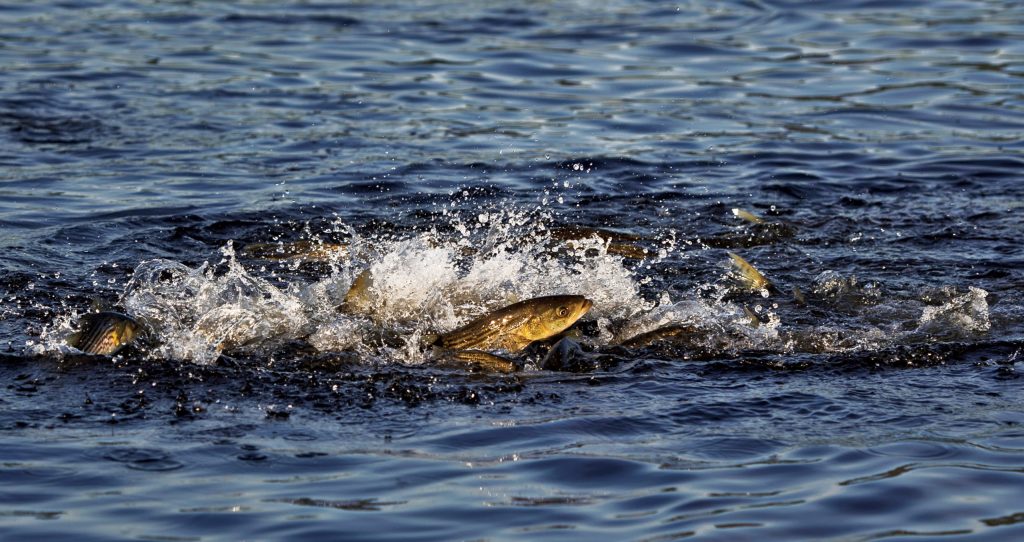Bass Blockade Bypass: The Trap & Truck Solution
On February 13th, 2025, the Atlantic Salmon Federation shared the following story by their NB Program Director, David Roth:
In the spring of 2024, the Atlantic Salmon Federation (ASF) partnered with the North Shore Mi’kmaq Tribal Council (NSMTC), the Miramichi Salmon Association (MSA) and the Canadian Rivers Institute (CRI), with support from the Foundation for the Conservation of Atlantic Salmon (FCAS) to start a new project on the Northwest Miramichi. The Trap and Transport project is a multi-year research and conservation initiative that aims to increase survival rates of Atlantic salmon smolts leaving the Miramichi River. The need for this work arose from findings on salmon smolt survival revealed through previous independent studies conducted by ASF, the Department of Fisheries and Oceans Canada, and CRI, with support from the NSMTC’s Anqotum Resource Management department and the MSA.
Striped Bass Predation an Ongoing Issue
The results from the previous studies showed a drastic reduction of the outmigration smolts from the Miramichi River over time. In recent years the survival rates of juvenile Atlantic salmon from the Northwest branch of the Miramichi River into the Gulf of St. Lawrence are consistently below 10%. In contrast, survival in the nearby Restigouche and Cascapedia Rivers remains well above 60%. This drastic reduction in survival is largely due to predation by striped bass, a species native to the Miramichi River. Striped bass have seen an incredible recovery in the Southern Gulf of St. Lawrence region, with their population rebounding from a historic low of a few thousand fish in the mid-90s to several hundred thousand spawners in the last decade. The spatial and temporal overlap of the two species occurs during the outmigration period of salmon smolts and the spawning season of striped bass, reducing smolt survival in the river.

A Novel Approach
The Trap and Transport project was designed to determine the viability of bypassing this high mortality bottleneck in the river, as a means to increase the number of smolts entering the ocean and, in time, the number of adults returning to the river to spawn. Partners collected smolts upriver of where predation of striped bass occurs and transported them downriver, releasing them in proximity to the mouth of the river.
All collected fish are equipped with an electronic tag, and half of the collected fish will be transported to the downriver release site, while the other half will be released back into the river at the collection site to act as a control group for the study. The study uses two different types of tags. Acoustic tags allow for the monitoring of short-term survival of marked fish from within the river to the Straight of Belle Isle, covering the first initial part of the journey. As acoustic tags are limited by a battery life that does not last until the fish return as adults, Passive Integrated Transponder (PIT) tags are used to evaluate the long-term survival of the smolts to returning adults.
Looking Forward
Currently, the project is designed at an experimental scale to evaluate the potential increase in outmigration survival and to study the number of returning adults from transported fish versus naturally out-migrating smolts. For the upcoming season, project partners are preparing to transport up to 5000 smolts in the Northwest Miramichi River. Depending on the findings of this work and future trends in salmon numbers in the Miramichi River, the project could be upscaled to collect and transport a greater number of smolts in future years.
The trap and transport project serves as an immediate, short-term solution. While it has the potential to increase the number of returning adults, it is imperative that all stakeholders and rightsholders work together to address other underlying issues occurring during the ocean migration and protect the nursery areas for juvenile salmon. All of the partners agree that this must be done in conjunction with broader initiatives to restore runs of other diadromous species, such as rainbow smelt, to maintain the ecosystem balance between prey and predators, while simultaneously looking at temporary methods to mitigate predation pressure on the Miramichi smolts. We must continue to protect the rivers and the surrounding landscape to provide a suitable freshwater environment for juvenile Atlantic salmon and all other species that are reliant on clean, cold water while further exploring the challenges found during the oceanic journey in the context of a changing climate.

To read the original story, visit: https://www.asf.ca/bass-blockade-bypass-the-trap-truck-solution/
